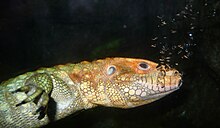Northern caiman lizard
| Northern Caiman Lizard | |
|---|---|

| |
| Northern caiman lizard resting on branch. | |
| Scientific classification | |
| Kingdom: | |
| Phylum: | |
| Class: | |
| Order: | |
| Family: | |
| Genus: | |
| Species: | D. guianensis
|
| Binomial name | |
| Dracaena guianensis Daudin, 1802
| |
The Northern Caiman Lizard is a species of lizard found in northeastern South America.
Appearance
The Caiman Lizard is build simliarly to its cousin the tegu, with a heavy set body and short but powerful limbs. Its head is bulky and often a red or ornage color. Their jaws are heavily muscular to help aid in eatting its normal pray of snails, crawfish and fresh water clams. It also has a few adaptaions that helps it in its watery habitate. It has a long and flattened tail, similar to its name sac the Caiman. This long tail helps the Caiman Liazrd to swim and dive. It also has a clear third eyelid which is thought to act like a pair of googles underwater.
The body of the caiman lizard is very simalar to that of a crocodile. Its typically a bright green with slight dark green banding. There are horned raised scales along the dorsal of the back. This help provided some protection agaist preditors.
These lizards can get 4 feet long and wieght close to 10lbs.
Distribution & Habitat
This species can be found in the countries of Brazil, Colombia, Ecuador, Peru, and Guyana. It lives in swampy habitats and other wooded areas which are usually flooded. It is very aquatic and an excellent climber. It spends its time basking in branches overhanging the water ways. If trouble was to arise its a quick drop into the water to safty.
The number of these lizards out in the wild is still unknown. There has not been a large study on them done in their natural habitate. Much what we know about them comes from captive animals in zoos and aquariums.
They were heavily hunted for thier leather in the early 90's. In 1970 they were provided protection and the export of their hides dorpped. Now local populations are safe where their habitate is protected. Captive farms have been set up to provided animals for the leather trade. In the last few years a few of these animals have found themselves in the pet trade.
Habits

The northern caiman lizard spends most of its time in or near water. At night, it hides in trees and bushes. Caiman lizards in the wild will take a variety of pray: snails, fish, crawfish, clams, invertabrate and other freshwater inhabitants all can make up a caiman lizards diet. However they do specialize in snails. It takes the snail in the jaws, raises its head up so that the prey will slide into the back of the mouth, then crushes it with its back teeth. It then spits out the pieces of shell.
References
- Dracaena guianensis, Reptile Database

